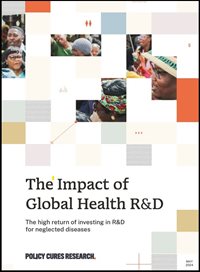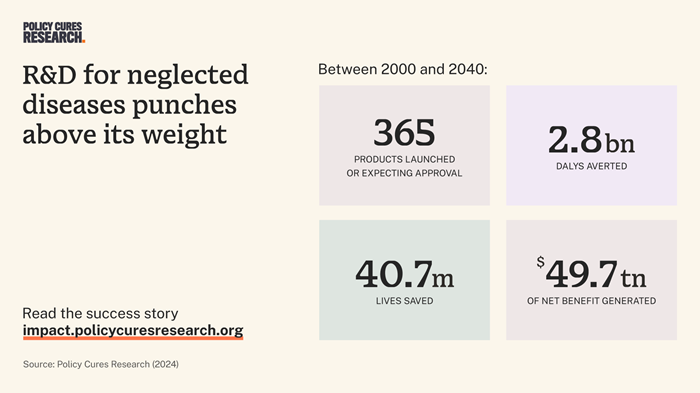
Paul Barnsley, PhD, is Research and Analysis Lead for Policy Cures Research, a global health research and policy organization that creates data and analysis to inform decision-making, with a mission to advance medical research and biomedical innovation for historically neglected and underfunded health issues. Policy Cures Research is best known for the
G-FINDER, which tracks R&D funding for new products and technologies that address global health challenges disproportionately affecting the world's most disadvantaged populations.
On May 28, Policy Cures Research released its new report,
The Impact of Global Health R&D, which determined that every dollar spent on neglected disease research and development (R&D) and developing life-saving products returns $405 in wider societal and economic gain. Dr.Barnsley spoke to ASTMH about the findings in the report and how the return on investment was quantified.
Tell us about how you got engaged in the project looking of looking at the impact of investment in global health/neglected disease R&D? What challenge were you were asked to solve?
Six years ago, when I joined Policy Cures Research, we were a very small think tank based almost exclusively in Sydney, Australia. And what we were known for, and what we spent the vast majority of our time doing, was the G-FINDER survey of research and development (R&D) funding for neglected diseases. We’ve just completed our
17th annual G-FINDER survey – which now covers emerging infectious diseases and sexual and reproductive health alongside neglected disease – and we believe it provides an incredibly valuable way for the global health community to figure out where funding is coming from and where it’s going. But what it doesn’t do, we’ve realized, is tell stakeholders about the
impact of all that funding. G-FINDER can tell you that the world spent $2.58 billion on malaria vaccines between 2007 and 2022, but it doesn’t give you any kind of idea what all that money bought us.
T

hat was the idea behind
The Impact of Global Health R&D – with support from our sponsors at the Gates Foundation, Wellcome and Open Philanthropy, we wanted to leverage our existing knowledge of past funding and our increasing understanding of the product pipeline to say something meaningful about the return on investment from neglected disease R&D. Our very ambitious goal was to think about
all the drugs and vaccines and diagnostics and vector controls and biologics that have either begun or finished their development since the turn of the century, and to try to figure out how much all of that had cost, and would end up costing, and to attempt to total up the impact they would end up having on global health.

So, we began with three very big questions: which products are we talking about, how much did they all cost, and – the big one – how many lives would they end up saving? The funding question was in many ways the easiest, because it drew on the work we’ve now been doing for nearly two decades. We knew what the world spent on R&D for neglected diseases between 2007 and 2022 and we just needed to figure out how much funding came before that window – back when these products first began as basic scientific research – and how much more money would be needed to finish off the products still in the pipeline today. So, we built a model to “backcast” what we knew about funding in 2007 to take that all the way back to 1994; and we borrowed another model to estimate how much its likely to cost to finish off, say, a vaccine that’s currently in Phase II trials.
Next, we mapped out all the different products for neglected disease that had launched this century and, separately, everything in the pipeline that we determined was likely to actually make it out into the world, and came up with estimates of
when these launches were likely to happen. That just left the hardest question: how much impact would all these products end up delivering? A lot of this is epidemiological modelling – how the incidence and burden of a disease will change as you roll out a new diagnostic, treatment or vaccine – that was conducted by our partners at Avenir Health. They were able to use their existing disease models to turn our timelines into predictions about cases averted and lives saved. The final piece of the puzzle was turning these predictions into a measure of a kind of “quantity of health” saved – we used the Disability Adjusted Life Year, or DALY, which is pretty standard in these kinds of international comparisons – and then turn
that into a dollar figure, so we could compare the value of the impact to the value of the money spent. I’m skipping over a lot of the details. There were a huge number of tough methodological decisions and years of work underlying every step of this process. That last part, for example, me just breezily saying “and then we put a dollar value on human life!” was actually the subject of months of technical and philosophical debates that featured something called “the income elasticity of the value of a statistical life year” (we think it’s 1.2) – so I hope I haven’t made any part of the process sound easy or straightforward. It really wasn’t.
After all that, what did we find? I’d encourage anyone who wants to dig into the results to
read the short summary report or have a poke around the
project’s website. The two key numbers I’d like to highlight are the headline figure of 40.7 million lives saved between 2000 and 2040, and the 405:1 overall return on investment for funding neglected disease R&D – that’s $405 worth of impact for every dollar spent on R&D.
Your finding that R&D for neglected diseases returns $405 for every dollar spent is a surprisingly large number. Is that number justifiable?
Yeah, $405 is a really big return on investment; much, much bigger than it takes to justify spending money on roads or bridges, or schools or hospitals, or whatever. The first thing we did once we arrived at that figure was to go back and recheck all our calculations, all our spreadsheets, just making sure we hadn’t missed a decimal point somewhere. Because, going in, we’d been hopeful that we’d be able to show that neglected disease R&D was a good use of money, but I don’t think we really imagined the return would be
this high.

The first thing I’d say to put that $405 number in context, though, is that while these kinds of returns are basically unheard of for, say, infrastructure projects, they’re not atypical in global health. Disease burdens in low-income countries are huge, incredibly harmful, and fixable. So interventions targeting neglected disease can often save a life for a few thousand, or even a few hundred dollars, which is the sort of ballpark we’ve ended up in.
The second point is that, what’s driving this $405 number isn’t really any of the technical economic calculations; it’s the sheer scale of 40.7
million lives saved. We set out to answer a big question: How many lives would all these products end up saving, and we got a really big answer because we looked at a wider range of diseases and products and countries than most studies set out to – and because we adopted a really long-time horizon, looking far into the future as well as measuring the gains that have already occurred. We think that ambitious question was the right one to have asked and, given that, finding a big impact in terms of lives saved makes perfect sense.
I guess the final thing I’d say about the $405 number is that, while we had to make a lot of detailed economic assumptions to get from 40.7 million lives saved to nearly $50
trillion in economic impact, none of those assumptions made a huge difference to our final result. My view as a professional health economist is that there are a lot of outdated approaches that do a poor job of capturing the value of lives saved in low-income countries, and that the approach we settled on is the best one. But I know that a lot of smart, professional health economists disagree with me. We tried to chart a middle ground through a lot of the technical controversies around valuing health impact in poor countries, but what we also did was to run a bunch of sensitivity analyses, asking, What if we’re wrong about this? You can see all of this in the report, but the short version is that, if you mess with the assumptions we made, that $405 figure changes – it can go up or down – but it never becomes
small. If we play around with a higher discount rate, for example – if we say that we should be less patient and treat lives saved in the future as much less valuable than lives today – that can drive the ROI down to $266. That’s still a massive return. The most extreme change we considered was to value people’s lives solely based on the value of the goods and services they produce over their lifetime – so your life is only as a valuable as the stuff you make. That makes people’s saving lives look
much less important, because it says if you’re retired or unemployed you have no value to society. I think that’s wrong and, honestly, kind of dumb, but even if you do take that radical approach, it knocks the return on investment down to $65. That’s
still a big number, still a great use of funds.
What is your personal outlook on the future of funding for neglected disease R&D? How are you hoping that the global health community, including the ASTMH community of scientist advocates, will utilize this information?
I think one big part of the message from this project is that we still have to finish the job. Our figures for impact and lives saved are partly a story about what’s already happened, but they’re partly a story about the future. A lot of the impact we modelled is still to come, and a lot of
that is from products that are still, today, in the pipeline, undergoing clinical trials. We had to predict what would happen with those products and, while we’ve been realistic about the fact that sometimes products just end up not working out, we’ve been fairly optimistic about them getting the funding they need. So, 40.7 million lives and a $405 return on investment is a forecast for a world where we do finish the job and complete the products waiting in the pipeline. It’s a prediction, but it’s also a call to action – those outcomes are possible, but they’re not guaranteed. That applies to the funding necessary to complete existing products, but also to all the other work that needs to be done, that we sort of assume away when we breezily talk about “roll out” – producing these products at scale, making them available to those who need them, managing cold chain deliveries to remote jungle villages and getting needles into infants’ arms. Our work underlines the value and the importance of all that work, even if it’s not our core focus.

One place where I think this report can do a lot of good is in making that argument, that we need to seize the chance to realize these massive gains. More generally, I think the numbers are very clear that funding for neglected disease R&D is, just in general, a wonderful investment. You can quibble with all the individual steps that ended up getting us to exactly $405, and that’s fine. Maybe, if your favorite health economists and epidemiologists and whoever sat down and spent a couple of years rerunning the numbers they’d end up with $382 or $255.
I don’t think so, but sure. But they’re
not going to end up saying it’s $6. Or 50 cents. Or negative three. So, this is a very specific number answering a very specific question. But it’s also a rock-solid broader case for investing in neglected disease R&D. It works; you should fund it.
And I guess the final thing I’d like people to take from the report is the value of patience. Research and development, sadly, doesn’t give you quick wins. The money that you put into basic research today isn’t going to save any lives for years, probably decades. But those impacts will arrive, and those lives saved in the long term will add up and up and up, until you have more than 40 million of them. It’s tough to put money into something that maybe isn’t going to fully pay off until you’ve retired. So, we want to salute the people – the policy makers and the funders and the researchers – who made that hard choice decades ago, and celebrate the people who are willing to do it again today.